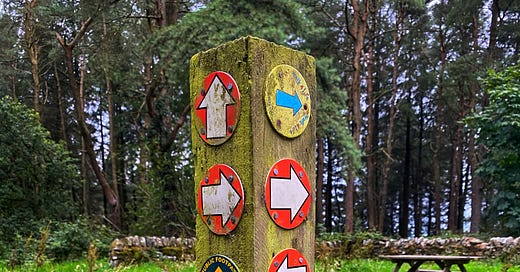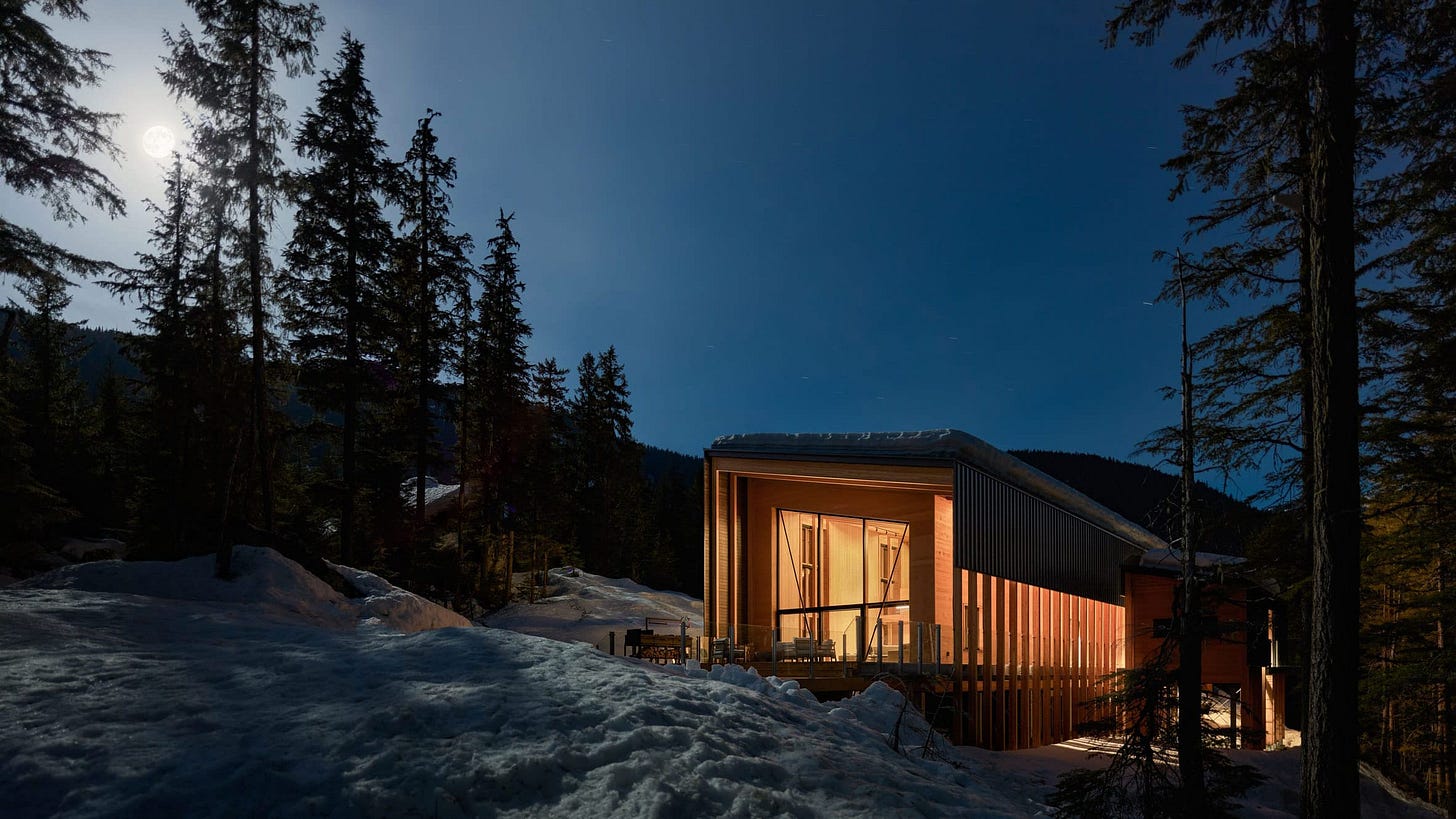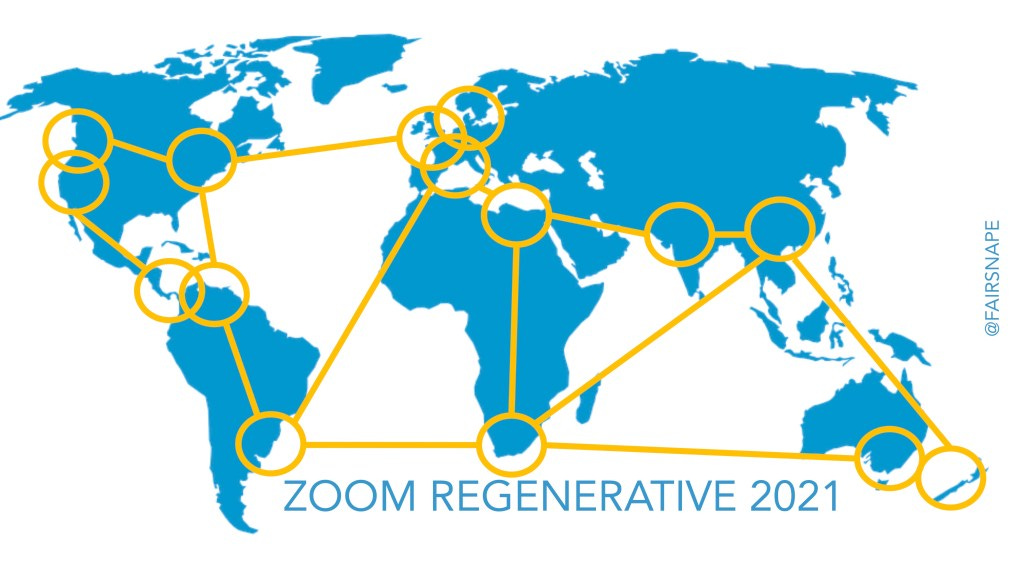Regen Notes 17
exploring carbon footprinting and handprinting in the light of the recent IPCC report.
Welcome to Regen Notes.
What does it feel like to live on the brink of a vast historical change?
It feels like now.
Kim Stanley Robinson.
Regen Notes is a newsletter of regenerative news, stories and more, curated by Martin Brown. It is a companion to Zoom Regenerative, where we join the regenerative dots, share the themes and work that invigorates, inspires and feeds our curiosity. This edition explores carbon footprinting in the light of the recent IPCC report.
Regen Notes is 100% reader-funded. If you value independent regenerative curation and journalism, please consider supporting as a free or a paid subscriber.
Net Zero?
Following the recent IPCC Report, Net zero targets are being announced daily and are becoming synonymous with climate leadership or ‘doing sustainability’. Amongst many well-meaning and positive approaches, we see green-washing and green-wishing. Can we consider carbon footprinting and offsetting regenerative or indeed even sustainable?
Should we worry when climate sceptics such as Nigel Farage have seemingly converted and starts a carbon offset business? Of course. As Damian Carrington reports: “So it’s goodbye climate deniers, hello – and you’ll pardon me for being blunt here – climate bullshitters”. We can add to this list the climate delayist, the greenwasher and the greenwisher. It is getting messy!
So how to spot greenwash? A good rule of thumb is whether the proposal actually removes emissions, by a significant amount, and soon, and whether the proposer is in fact making the climate emergency worse elsewhere.
An example surfaced recently via a LinkedIn post. A tree-planting-for-offset organisation offers offsets to plant 36 trees for each tank fill of fuel. A quick search online for the number of cars in the UK showed 31 million, and if all filled up just once a month, then the land required at the Woodland Trust’s recommended spacing would be just larger the footprint of England, EVERY year, and we would still be putting the carbons and pollutants into the atmosphere.
The language used is becoming messy and confusing, providing a mask for many to hide behind and do very little or nothing different. If a building design swaps a high embodied carbon material to a low carbon one - is that carbon reduction, carbon avoidance, net-zero, offsetting or just good design management? It may prevent less carbon from entering the atmosphere, but doesn’t take CO2 out of the atmosphere. It doesn’t meet the basic regenerative premise of ‘not only reducing impact but doing more good’. And of course, we no longer have the luxury of only reducing impact, only being less bad.
The September/October edition of Resurgence and Ecologist Magazine questions whether Net-Zero has become the catchphrase for politicians and businesses worldwide wanting to demonstrate commitment to solving the climate crisis. And, as the UK prepares to host COP26, asks if this goal is greenwash or our only hope of keeping global temperatures to under 1.5°C.
Rebecca Solnit reminds us that the carbon footprinting concept was a ploy from fossil fuel companies to make us fret on our footprints and distract from the bigger polluting picture.
British Petroleum, the second-largest non-state-owned oil company in the world, with 18,700 gas and service stations worldwide, hired the public relations professionals Ogilvy & Mather to promote the slant that climate change is not the fault of an oil giant, but that of individuals. It’s here that British Petroleum, or BP, first promoted and soon successfully popularised the term “carbon footprint” in the early aughts. The company unveiled its “carbon footprint calculator” in 2004 so one could assess how their normal daily life – going to work, buying food, and (gasp) travelling – is largely responsible for heating the globe.
Carbon footprints caught on, and I routinely see people on social media zooming in on individual consumption habits when climate chaos is under discussion. Bill McKibben made the case against them in 2008.
SSE is one of the UK’s biggest electricity suppliers and a “major partner” of the crucial UN Cop26 climate summit that the UK is hosting. It is also the only company currently building a new gas power plant in the UK. The good news then is that Glasgow City Council has passed a motion to prevent companies that “contribute towards catastrophic climate change” from its venues during COP26. It will be interesting to see how this one plays out.
Ed Gillespie holding no punches, sees consultants as being part of the problem, even if they (we) think as part of the solution. “Instead we are mired in the delusional sophistry of ‘Net Zero’, or ‘Not Zero’ as we might more mischievously put it. Not only are most corporate Net Zero strategies highly dependent on either offsetting, largely through tree planting or forest conservation with often ‘carbon colonialism’ overtones, or nascent carbon drawdown technologies not yet proven or workable or at a realistic price, but they are also predicated on increasing the lean efficiency of existing business models — which remain mainly unquestioned”
Nor does Fred A Bernstein on Dezeen, critical of a project built in a wilderness area that then claims carbon zero “Taking credit for trees planted elsewhere is a whole lot of embodied irony”
What if every piece of consultancy made the world a better place, contributing to decarbonisation? Vital then, that as consultants, whether we be creative, design, management, economists, ecologists … are aware of our own carbon handprints and scope 3 obligations (see below) in the advice given to clients.
Kim Stanley Robinson, (author of the awesome Ministry of the Future) writing in t eh Financial Times A climate plan for a world in flames suggests that we have to find ways of paying people to not only emit less but to capture more. Quantitive Easing for the climate: Even in our current political economy . . . we might be able to pay ourselves to do the necessary things and thus dodge the coming mass extinction event
Offsetting
Back in 2007, on my Fairsnape blog, I referred to offsetting as useful as chocolate teapots. With an irony that illustrates offset fragility, the forest fires burning in Oregon as a result of climate change are those forests planted to offset the carbons of many corporate organisations. What happens now to those offset carbons? Are they added back into the pool of emissions from the offseters (but with an increase in the carbon released from the fires), or placed in the dealt with box and forgotten?

Such fragility shows we cannot offset our way out of the carbon crisis.
Offsets sound good in theory but too often are fantasy accounting. Planting trees is a popular idea, but even if every possible new tree on the planet took root and started sucking up carbon, they would still be overwhelmed by fossil fuel emissions. Guardian
More focus on scope 3. 1
Monitoring an organisations scope 1 and 2 should be straightforward once the data is available. Scope 3 emissions require more focus and action
Greenhouse gas emissions are categorised into three groups or 'Scopes' by the most widely-used international accounting tool, the Greenhouse Gas (GHG) Protocol. Scope 1 covers direct emissions from owned or controlled sources. Scope 2 covers indirect emissions from the generation of purchased electricity, steam, heating and cooling consumed by the reporting company. Scope 3 includes all other indirect emissions that occur in a company’s value chain.
BREEAM and LEED have been called out for not addressing decarbonisation in Fast Company “Green Buildings conveniently ignore the emissions from their construction”. Calling for “a new paradigm in how we think about the emissions from the built environment”
A recent One Click LCA report noted our ILFI Zero Carbon as a leader in decarbonisation standards. But even here, M & E inclusion in embodied carbon calculations is optional. This should be addressed soon as we get better data, but from projects I audit the more significant carbon reductions between RIBA stages 3 and 4 are M & E related - think ducting, drainage, LED lighting and raised floor access.
The recently published report (Achieving Real Net-Zero Emission Homes) from Chris Magwood and others at Builders for Climate Action illustrates how it would be possible to decarbonise new (home) construction. The report explores the development of methodology for assessing carbon storage in materials, where tonne-year accounting indicates ‘that storing one tonne of CO2e from a biogenic source for approximately 46 years has the equivalent impact of averting one tonne of CO2e at year 0’

EN15978 details a sound framework for a building’s embedded and operating carbon. Yet this is light on a vital scope 3 component - the travel and transport of subcontracted operatives, which is deemed to be within the subcontractors’ domain to address. Yet scope 3 must become the project and or main contractor’s responsibility to ‘own’ those carbons. (ConstructCO2 shows that travel emissions in the construction phase, arguably only emitted because that project exists, can be around 70%)
And likewise, following Scope 3 upstream, it is the supply chain’s responsibility to help reduce client or customer emissions. To enable this a collaborative supply chain scoping exercise of mapping emissions and who manages/takes ownership is essential at the outset of any project.
Handprinting
The term carbon handprint refers to the positive environmental impact of a product throughout its life cycle. VTT Carbon Handprint Guide
With the carbon footprint concept the goal is simple – to get the footprint close to zero, but with handprints, there is essentially no limit to the positive impacts that can be achieved. The purpose of carbon handprint assessment is to calculate the beneficial greenhouse gas impacts of a product when used by a (potential) customer.
The carbon handprint approach is built on the principle that reducing one’s footprint is not a good handprint. Instead, a good handprint is achieved by improving the performance of another actor – by reducing their carbon footprint.
Awareness and literacy are key areas to address here and must be high on climate action plans. Architects who work on small-scale domestic projects are being urged to get carbon-literate so they can help their clients tackle the climate emergency, one scheme at a time.
The Regenerative Self
We are on the verge of something regeneratively wonderful - or irreversibly catastrophic.
Can we progress on carbon ambitions and targets without understanding our regenerative self? The self that can make informed and conscious decisions. Decisions not only at a project level but for human and non-human communities through time. Decisions where reciprocity actions do not expect a personal or immediate return but heals the future for generations way down the line.
Our regenerative self recognises that all is connected, understands carbon ecology, how nature works and the interplay and importance of biodiversity. Interbeing.

As Rose Marcario (ex CEO Patagonia) commented in her recent Linkedin post, “Wherever you are, whatever stage on the journey to making a better world, be a steward of our planet’s revival. We need everyone in this together.”
And Rebecca Solnit in the Guardian, ”Climate chaos demands we recognize how everything is connected. Seeing yourself as a citizen means seeing yourself as connected to social and political systems. As citizens, we must go after the climate footprint of the fossil-fuel corporations, the beef industry, the power companies, the transportation system, plastics, and so much more”
And Ed Gillespie again,“... things are about to get really bumpy whether we like it, or even ‘believe’ it, or not. The time for smooth, managed and painless transitions has long since passed. We will likely see more radical progress even as the felt experience of climate change actually becomes more extreme. And that requires us to be truly honest with ourselves”
Essentials
Zoom Regenerative re-zooms on 14th of September with a new focus and format.
ZR37 will be part 1 to 1 connecting (our famed ZR format that has led to so many connections, collaborations, contracts and friendships) and part unconference approach to explore regenerative built environments in the light of the recent IPCC report.
Invites for ZR37 will be sent to all who have attended previous events and subscribers to this newsletter.
Zoom Regen in Conversation … our new podcast series launches on September 7th, starting with our conversation with Sophie Lacey
Our LFE Masterclass starts in the September and runs through to December with a COP26 session. We still have a couple of places available. See here for detail
COP26 events are increasing. Regen Notes will start to list those we see of interest.
Carbon Literacy plan a mass literacy day on the 01 November
Co-hosted by RIBA and Architects Declare, the Built Environment Summit (BESt) will take place in London from 28-29 October 2021. The summit will share examples of innovative practice and explore ways to harness political support to decarbonise the built environment, ahead of COP26.
Zoom Regenerative will have a special on 16th Nov to explore and understand the outcomes from COP26
Keep Connected with Link Tree
Greenhouse gas emissions are categorised into three groups or 'Scopes' by the Greenhouse Gas (GHG) Protocol. Scope 1 covers direct emissions from owned or controlled sources. Scope 2 covers indirect emissions from the generation of purchased electricity, steam, heating and cooling consumed. Scope 3 includes all other emissions that occur in a company’s value chain.









